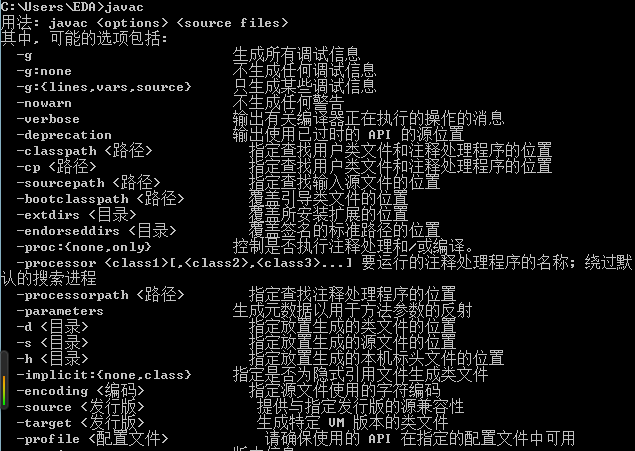配置Java开发环境
Installing JDK(点击这里)
The Java Development Kit (JDK) is a software development environment used for developing Java applications and applets. It includes the Java Runtime Environment (JRE), an interpreter/loader (java), a compiler (javac), an archiver (jar), a documentation generator (javadoc) and other tools needed in Java development.
JDK在安装完毕后,包含的目录层级中,bin 目录包含 compiler 和 launcher.
Set the PATH environment variable if you want to be able to conveniently run the executables (javac.exe, java.exe, javadoc.exe, and so on) from any directory without having to type the full path of the command. If you do not set the PATH variable, you need to specify the full path to the executable every time you run it, such as:
C:\Program Files\Java\jdk1.8.0_65\bin\javac MyClass.java
The PATH environment variable is a series of directories separated by semicolons (;). Microsoft Windows looks for programs in the PATH directories in order, from left to right. You should have only one bin directory for the JDK in the path at a time (those following the first are ignored), so if one is already present, you can update that particular entry.
The following is an example of a PATH environment variable:
C:\Program Files\Java\jdk1.8.0_65\bin;C:\Windows\System32\;C:\Windows\;C:\Windows\System32\Wbem
It is useful to set the PATH environment variable permanently so it will persist after rebooting. To make a permanent change to the PATH variable, use the System icon in the Control Panel. The precise procedure varies depending on the version of Windows .
The CLASSPATH variable is one way to tell applications, including the JDK tools, where to look for user classes. (Classes that are part of the JRE, JDK platform, and extensions should be defined through other means, such as the bootstrap class path or the extensions directory.)
The CLASSPATH is the path that the Java Runtime Environment (JRE) searches for classes and other resource files.
The same applies not only to java launcher but also to javac, the java compiler.You can set it as it was shown here through GUI or command line instruction as below.The class path tells the JDK tools and applications where to find third-party and user-defined classes that are not extensions or part of the Java platform.You can customize it as your own wish.
When we invoke Java, we specify the name of the application to run: org.mypackage.HelloWorld. However we must also tell Java where to look for the files and directories defining our package. So to launch the program, we use the following command:
java -classpath D:\myprogram org.mypackage.HelloWorld
java is a java application launcher, a type of sdkTool(A command-line tool, such as javac, javadoc, or apt)
-classpath D:\myprogram sets the path to the packages used in the program and org.mypackage.HelloWorld is the name of the main class(主类).
The preferred way to specify the class path is by using the -cp command line switch(on Linux, -cp /home/user/myprogram) . This allows the CLASSPATH to be set individually for each application without affecting other applications. Setting the CLASSPATH can be tricky and should be performed with care.
The default value of the CLASSPATH is ".", meaning that only the current directory is searched. Specifying either the CLASSPATH variable or the -cp command line switch overrides this value.
To check whether CLASSPATH is set on Microsoft Windows NT/2000/XP, execute the following:
C:> echo %CLASSPATH%
JAVA_HOME is the directory you install your jdk.In this case it is
C:\Program Files\Java\jdk1.8.0_65
If CLASSPATH is not set you will get a CLASSPATH: Undefined variable error (Solaris or Linux) or simply %CLASSPATH% (Microsoft Windows NT/2000/XP).
To modify the CLASSPATH, use the same procedure you used for the PATH variable.
CLASSPATH wildcards allow you to include an entire directory of .jar files in the class path without explicitly naming them individually. For more information, including an explanation of CLASSPATH wildcards, and a detailed description on how to clean up the CLASSPATH environment variable, see the Setting the Class Path technical note.
Right Click on MyComputer and click on properties .Click on Advanced tab.Click on Environment Variables.Create a new CLASSPATH for JAVA_HOME.Enter the Variable name as JAVA_HOME and the value to your jdk bin path ie
C:\Program Files\Java\jdk1.8.0_65\bin
and Make sure u start with .; in the value so that it doesn't corrupt the other environment variables which is already set.Follow the Above step and edit the Path in System Variables add the following ;
C:\Program Files\Java\jdk1.8.0_65\bin
in the value column.
Your are done setting up your environment variables for your Java , In order to test it go to command prompt and type:
java
who will get a list of help doc.
或者
java -version
you can get the version information.
In order make sure whether compiler is setup Type in cmd:
javac
get a list related to javac.
Installing Eclipse IDE for Java EE Developers(点击这里)
Eclipse is a Java-based open source platform that allows a software developer to create a customized development environment (IDE) from plug-in components built by Eclipse members. Eclipse is managed and directed by the Eclipse.org Consortium.
and install the server of tomcat as below,
Creating the Eclipse Projects using Maven 3(点击这里)
Maven is a build automation tool used primarily for Java projects. The word maven means "accumulator of knowledge" in Yiddish. Maven addresses two aspects of building software: First, it describes how software is built, and second, it describes its dependencies







